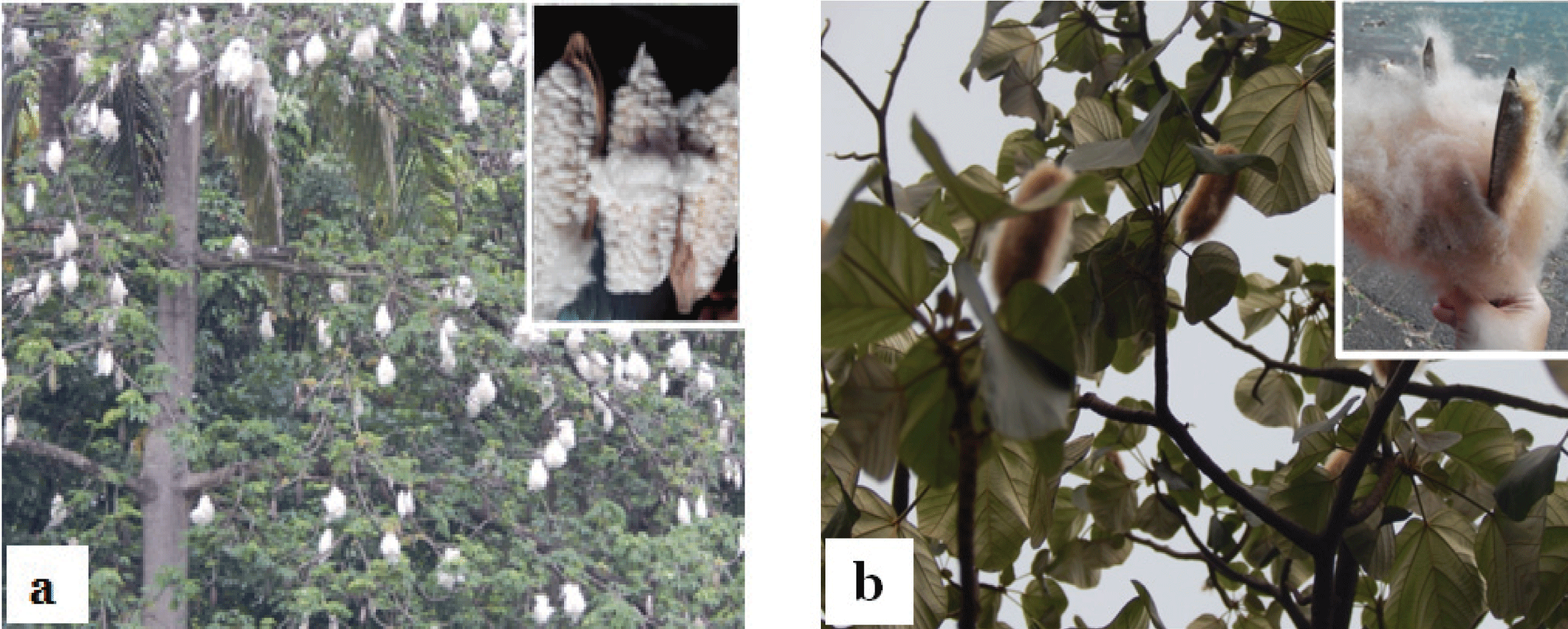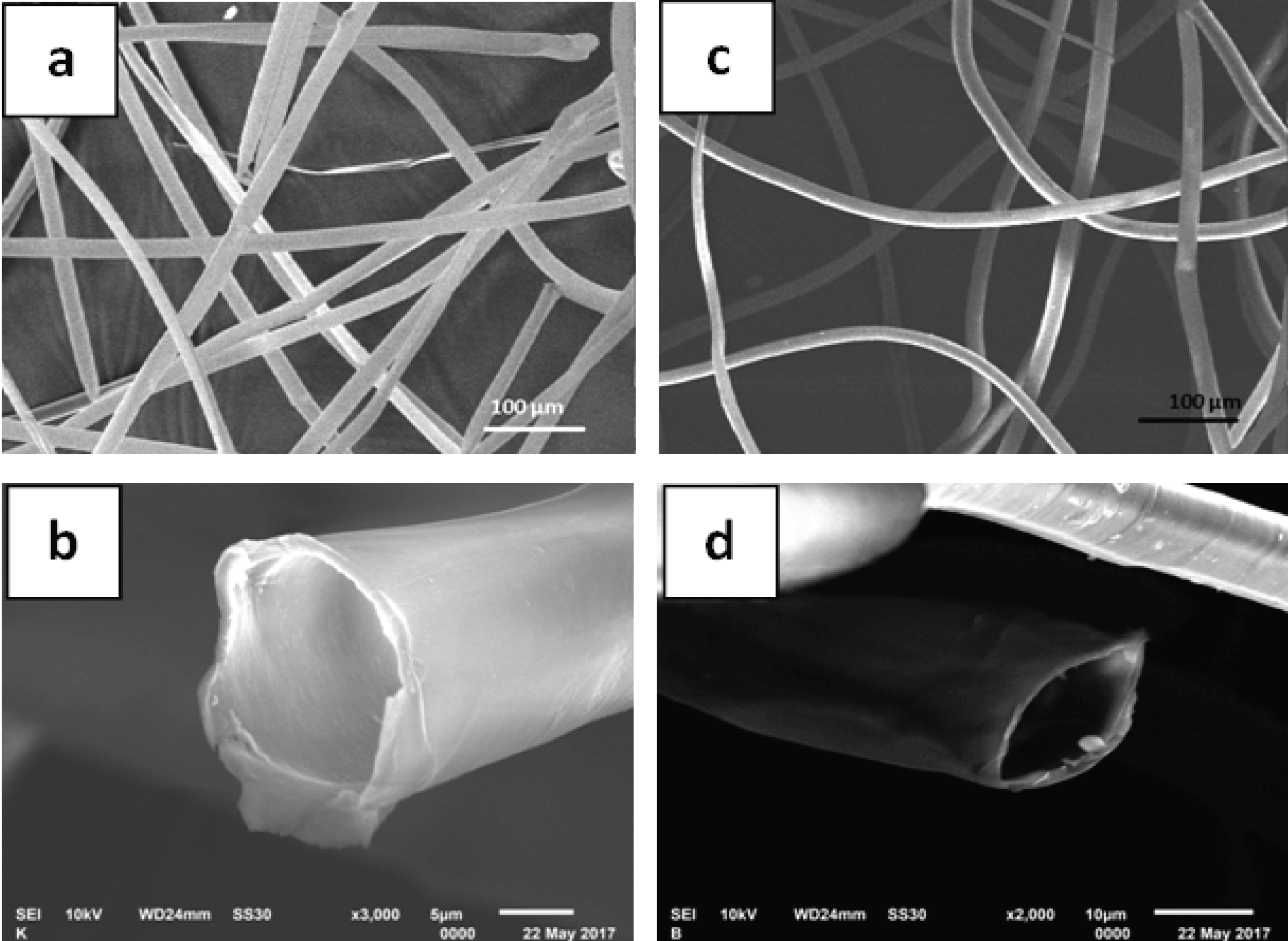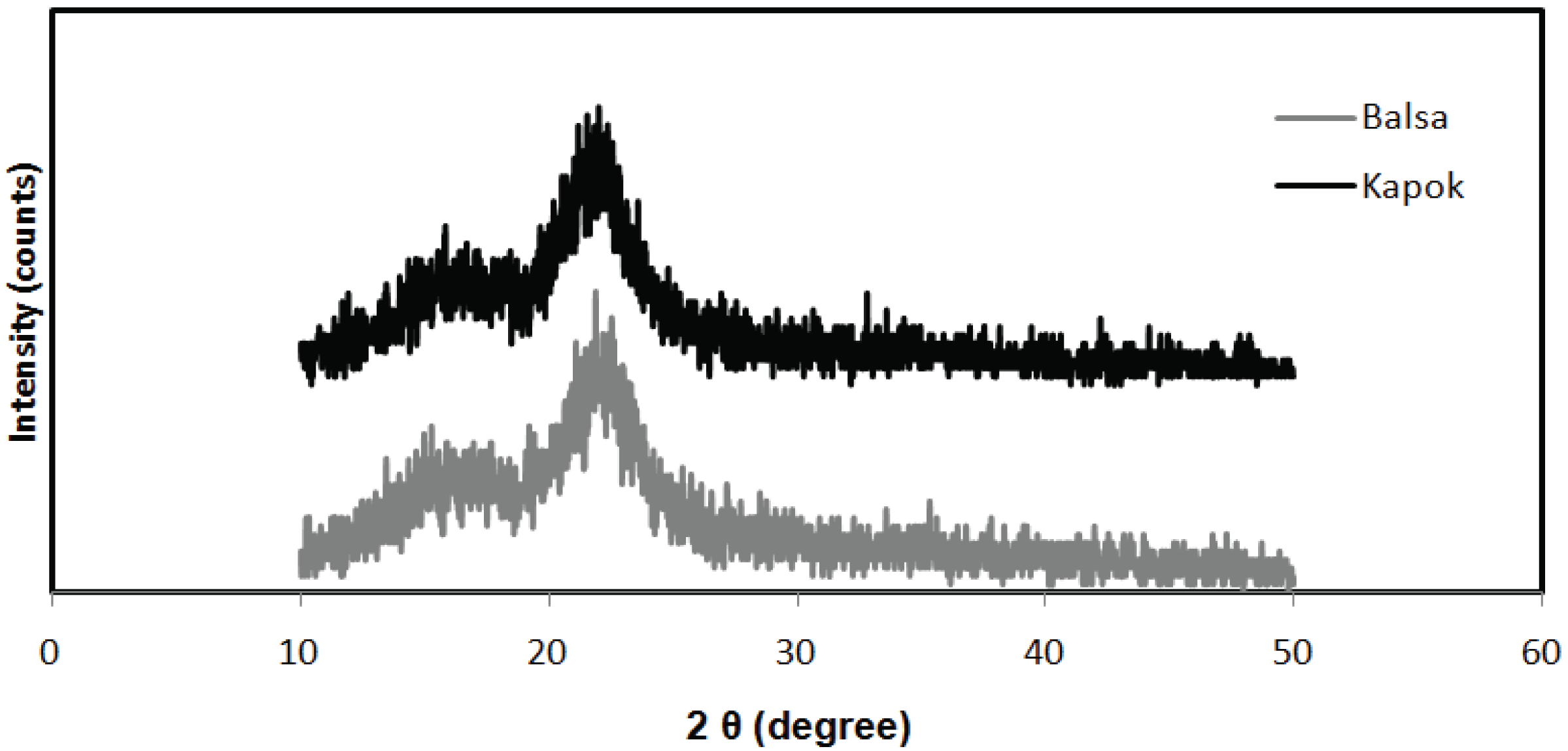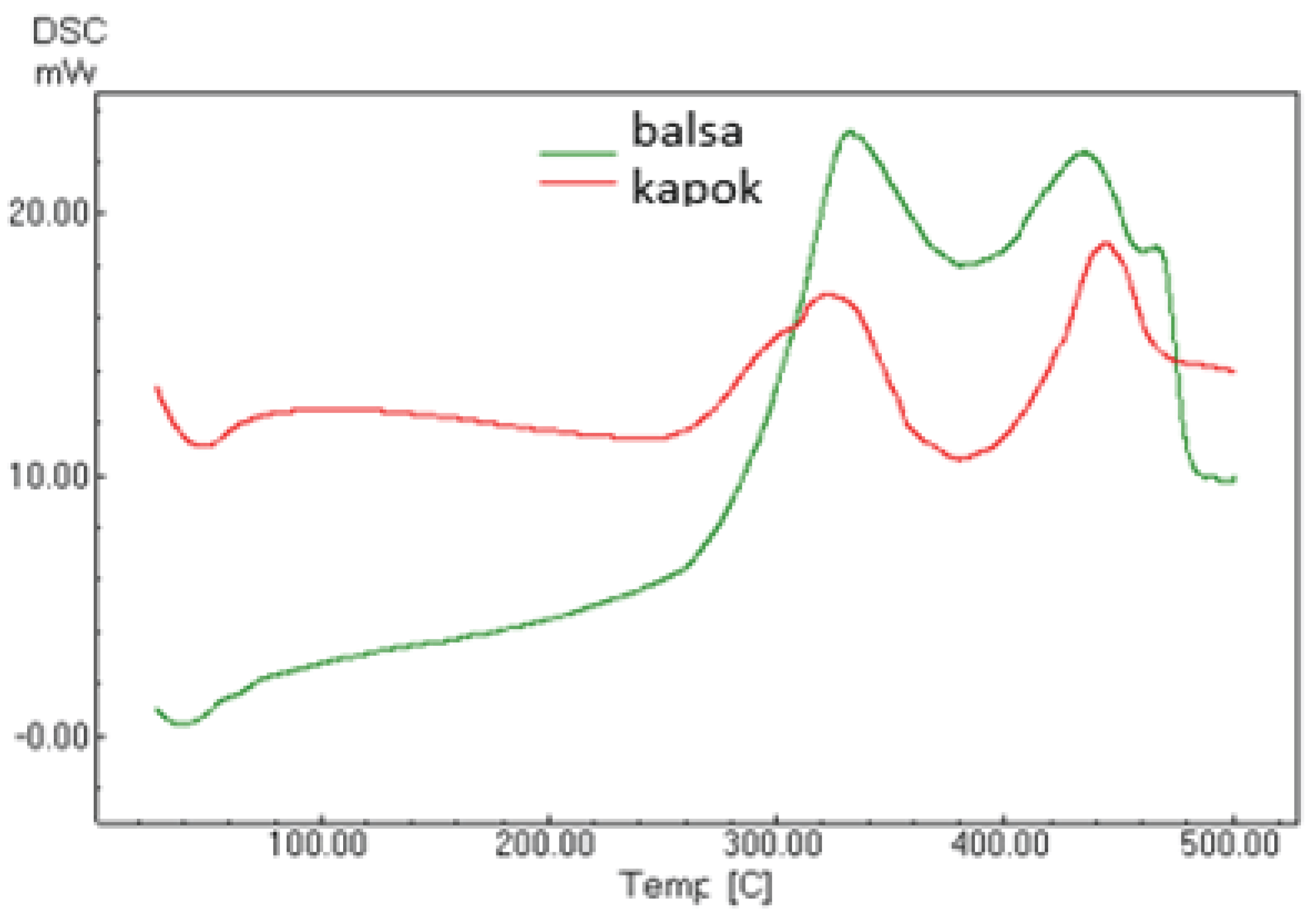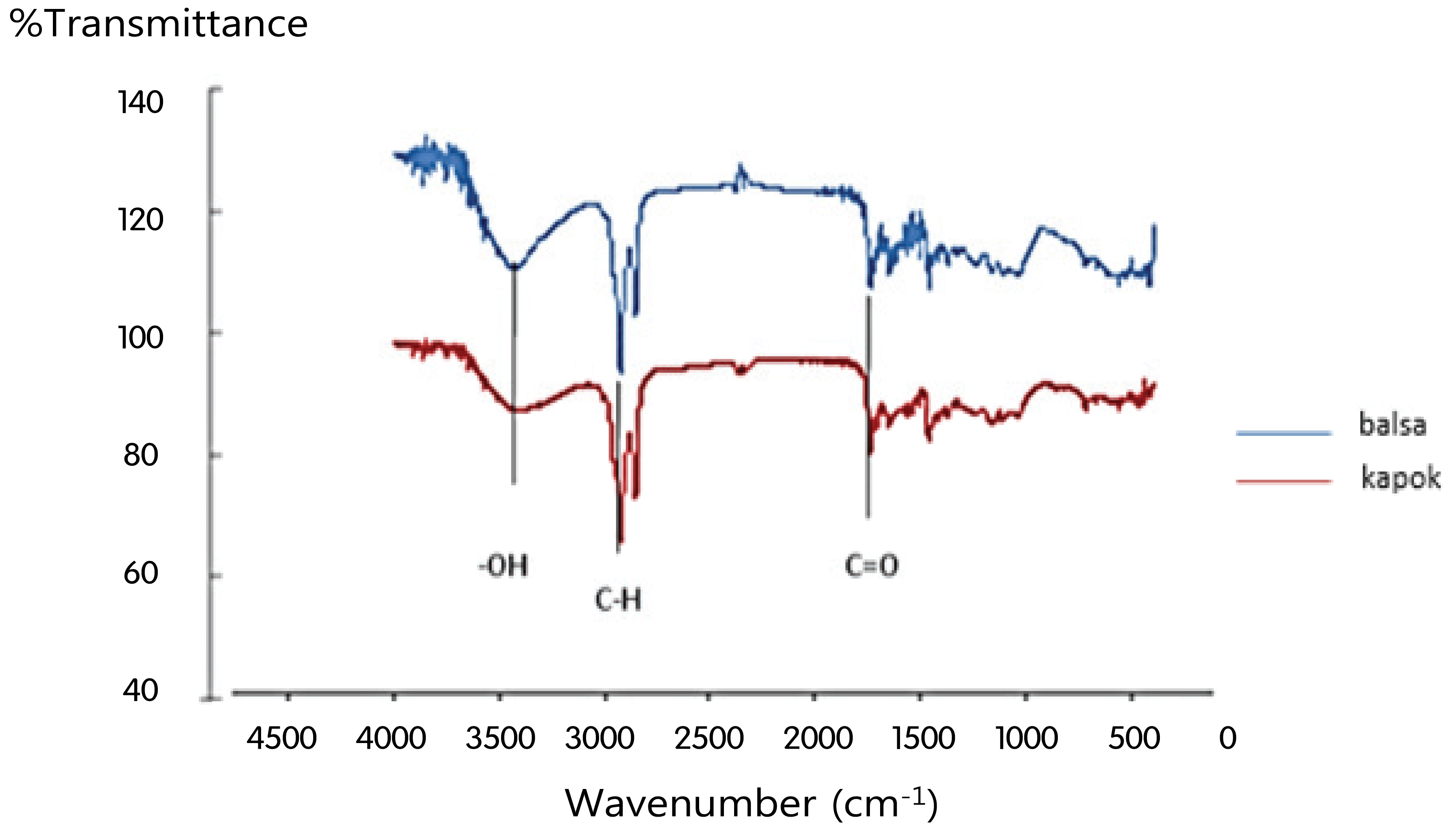1. INTRODUCTION
Indonesia has a large amount of natural lignocellulosic fibers with potential use in a variety of industrial products based on available technology. Despite some technological advancement, specific characteristics of the materials have become an important factor in developing new fiber-based products. Several natural fibers with the potential to be developed are fibers from the fruit of kapok (Ceiba pentandra) and balsa (Ochroma pyramidale); however, these fibers, especially balsa fibers, have not been thoroughly studied until now.
Indonesia is one of the world's biggest kapok exporters. Around 52,800 tons of kapok were produced from 143.7 ha of community plantations in Java (BPS, 2015). Meanwhile, balsa wood is one of the fast-growing species in Indonesian plantation forests, and the fibers from its fruits could add to the product value.
Balsa and kapok fibers have similar physical properties. Kapok trees are widely distributed in tropical areas. They are 60-70 m tall, their trunks expand to 3 m in diameter, and they have palm-shaped leaves. An adult kapok tree produces hundreds of seedpods with black seeds and yellow fibers. The extracted fibers are smooth and light; they are used in manufacturing pillows, life preservers, sleeping bags, and insulation. Moreover, kapok has also been investigated as an absorbent material for oil and acoustic insulation (Likon et al., 2013; Wang et al., 2012; Rengasamy et al., 2011; Veerakumar and Selvakumar, 2010).
Balsa trees are fast-growing evergreen trees that can reach up to 30 m in height and 1.8 m in diameter at breast height. They typically have buttress roots. They have a reputation as the lightest commercial wood for various purposes. The silky fibers of its fruit can be used as a material for pillows, mattresses, and cushions. Nevertheless, there are no detailed studies previously reported on the basic properties of balsa fiber.
Kapok and balsa fibers as natural resources can potentially be developed for several applications (Purnawati et al., 2018). However, the characteristics of kapok and balsa fibers must be identified in order to determine their suitability for various applications and products. The purpose of this study was to analyze some important properties of kapok and balsa fibers, including their morphology, chemical composition, relative crystallinity, thermal properties, and wettability.
2. MATERIALS and METHODS
Kapok and balsa seedpods were obtained from the plant collection of Bogor Agricultural University, Dramaga, West Java (Fig. 1).
Kapok and balsa fibers were removed from their pods, separated from their seeds, and dried at room temperature (25 °C). The fibers were then ground to 40-60 mesh size for the purpose of chemical component analysis.
Kapok and balsa fibers were successively rinsed with 10%, 30%, and 50% aqueous ethanol. Then, the fibers were stained with 1% safranine solution for 24 h. Finally, they were rinsed with 50% ethanol to remove the excess dye. Fiber morphology was observed by digital photomicroscopy (Carton CB-10, Thailand) using a 5 MP USB eyepiece camera. Fiber dimensions (length, diameter, and cell wall thickness) were analyzed by FIJI ImageJ 1.51p software for Windows.
Fiber morphology was also analyzed using scanning electron microscopy (SEM; JEOL-JSM-6510) at an accelerating voltage of 10 kV. Samples were placed on a carbon tape attached to a 1-cm-diameter holder and coated with osmium.
The relative crystallinity index (CrI) of the materials was tested using an X-ray diffractometer (XRD, Shimadzu XRD-7000 MaximaX series). A Ni-filtered CuKα X-ray operating at 40 kV and 30 mA was used to analyze the cellulose crystalline properties for both fibers. Relative crystallinity was calculated by the following formula (Segal et al., 1959):
where I200 is the maximum intensity of the lattice diffraction of cellulose type I and Iam is the intensity diffraction of the amorphous cellulose.
The size of the crystals (т) was calculated using the Scherrer equation (Smilgies, 2009) as follows:
where т is the mean size of the ordered (crystalline) domains, K is the shape factor (approximately 0.9), λ is the X-ray wavelength, β is the line full-width at half-maximal intensity, and θ is the Bragg angle.
The sessile-drop method was chosen for contact angle measurement, and the dynamic contact angle was determined using a Phoenix 300 Contact Angle Analyzer (Surface Electro Optics, Korea) (Suryadi, 2017). Demineralized water and methanol were used as the polar liquids, and hexane was used as the non-polar liquid. The three-probe liquids were placed on the surface of the fiber. Each droplet was 5 μL in volume, and a total of three droplets were analyzed for each liquid. The contact angle measurement was performed by capturing a droplet image using Surfaceware 8 software and a camera-based contact angle analysis system. The process of capturing the image was continuously conducted at the beginning of the test, after 5 min, and after 10 min. The angles were measured on both sides of the droplet. All tests were carried out at room temperature (25 °C).
Kapok and balsa fibers were tested by differential scanning calorimetry (DSC) to measure the thermal transition of the fibers. A fiber sample of approximately 10 mg was placed in a small aluminum crucible and subjected to a temperature program; Shimadzu DSC-60 was operated in a dynamic mode in the temperature range of 30 °C to 500 °C and a heating rate of 10 °C/min in a nitrogen environment purged at 25 mL/min.
The chemical compositions, including extractives, ash, and lignin content, of kapok and balsa fibers were determined in accordance with the TAPPI standards (TAPPI T204 om-88, 1988; TAPPI T211 om-02, 2002; and TAPPI T222 om-88, 1988). The holocellulose (α -cellulose + hemicellulose) content was estimated by the acid chloride method, and the α-cellulose content was determined by treating the holocellulose with a sodium hydroxide solution (Browning, 1967). Wax content was determined in accordance with the AATCC Test Method 97 (American Association of Textile Chemists and Colorists, 2012).
The functional groups in kapok and balsa fibers were determined using Fourier-transform infrared (FTIR) spectroscopy (MB3000 ABB). Approximately 2 mg of fiber was mashed, mixed with 200 mg KBr, and then pressed into 1-mm-thick disks. The spectra were recorded in the range of 4000‒450 cm-1.
3. RESULTS and DISCUSSION
Examination by SEM showed that kapok and balsa fibers had a hollow structure with a thin fiber wall and a large lumen filled with air (Fig. 2b and Fig. 2d). Single-cell seed fibers such as kapok, balsa, and cotton are different from other natural fibers such as wood, hemp, jute etc. Unicellular cellulosic fibers are typically oval- or cylindrical, are long with pointed ends, and have thin cell walls with large lumens, which led to low fiber densities for both kapok and balsa.
Meiwu et al. (2010) and Mwaikambo (2006) stated that kapok was the lightest fiber in the world. The apparent specific gravity of the Indian kapok fiber was approximately 0.0554, whereas that of Japanese kapok was approximately 0.0388. Moreover, kapok fiber was six times lighter than cotton (Mwaikambo, 2006). Meanwhile, cotton fiber had a density of 0.29 g/cm3 according to a study conducted by Meiwu et al. (2010).
Balsa fiber had a light brown color, whereas kapok had a yellowish white color. Both fibers were luminous because of the wax content of the fiber surface, showing similarity to the silk fibers. Both fibers were about two times longer than non-timber lignocellulosic fibers, such as pineapple, corn, coconut, bagasse, banana, hay, and sorghum (Reddy and Yang, 2005). However, the kapok and balsa fiber lengths were shorter than those of cotton, hemp, and flax (Mwaikambo, 2006).
Parameters such as fiber length, diameter, and cell wall thickness of kapok and balsa are shown in Table 1. The length of the kapok fiber ranged from 13.79 to 18.84 mm, whereas that of balsa ranged from 10.36 to 15.70 mm. Kapok fibers were longer than balsa fibers, but their diameter and cell wall thickness were less than those of balsa fibers. Kapok fibers had an exceptional liquid-retention capability considering their large lumens. Their excellent thermal and acoustic insulating properties, high buoyancy, and good absorbency for oil and other non-polar liquids distinguish kapok from most other cellulosic fibers (Wang et al., 2012; Lim and Huang, 2007; Zheng et al.,, 2015). Balsa fibers may have similar properties because of their similar morphology.
| Dimension | Kapok | Balsa |
|---|---|---|
| Length (mm) | 16.32 ± 2.54 | 13.01 ± 2.69 |
| Width (μm) | 17.59 ± 3.72 | 19.25 ± 2.69 |
| Cell wall thickness (μm) | 1.34 ± 0.77 | 2.40 ± 0.97 |
Fig. 3 shows X-ray diffractograms that display peaks of 2θ= 22.15° in kapok fibers and 22.31° in balsa fibers, which are characteristic of cellulose type I crystals. The crystallinity index (CrI) of the kapok fiber was 35.65%, and that of balsa fiber was 31.40%. According to Poletto et al. (2014), the CrI for both fiber types was similar to the values for jute (34.3%), kenaf (34.9%), and ramie (34.8%).
Table 2 presents the crystallinity index (%) and the crystallite width for kapok and balsa fibers. The crystal widths of both fibers were larger than those of kenaf (Lee et al., 2008) and wood cellulose (Eun et al., 2008).
| Variable | Kapok | Balsa |
|---|---|---|
| Relative crystallinity (%) | 35.65 | 31.40 |
| Crystallite width (nm) | 4.70 | 3.70 |
The contact angles for the three types of liquid tested (water, methanol, and hexane) on kapok and balsa fibers after 0, 5, and 10 min following the droplet deposition are presented in Table 3.
The study of wettability uses contact angle measurements which simulate the degree of wetting during the interaction between solids and liquids. A small contact angle (<90°) refers to high wettability, whereas a large contact angle (>90°) refers to a low wettability.
Table 3 shows that the contact angle of water with kapok fiber was higher than that with balsa fiber. This phenomenon indicated a lower wettability for kapok fiber than that for balsa fiber. The larger the contact angle, the longer the liquid would stay above the fiber surface (i.e., low wettability). The other two test liquids, methanol and hexane, formed very small contact angles (Fig. 4) and exhibited much lower surface energies than water.
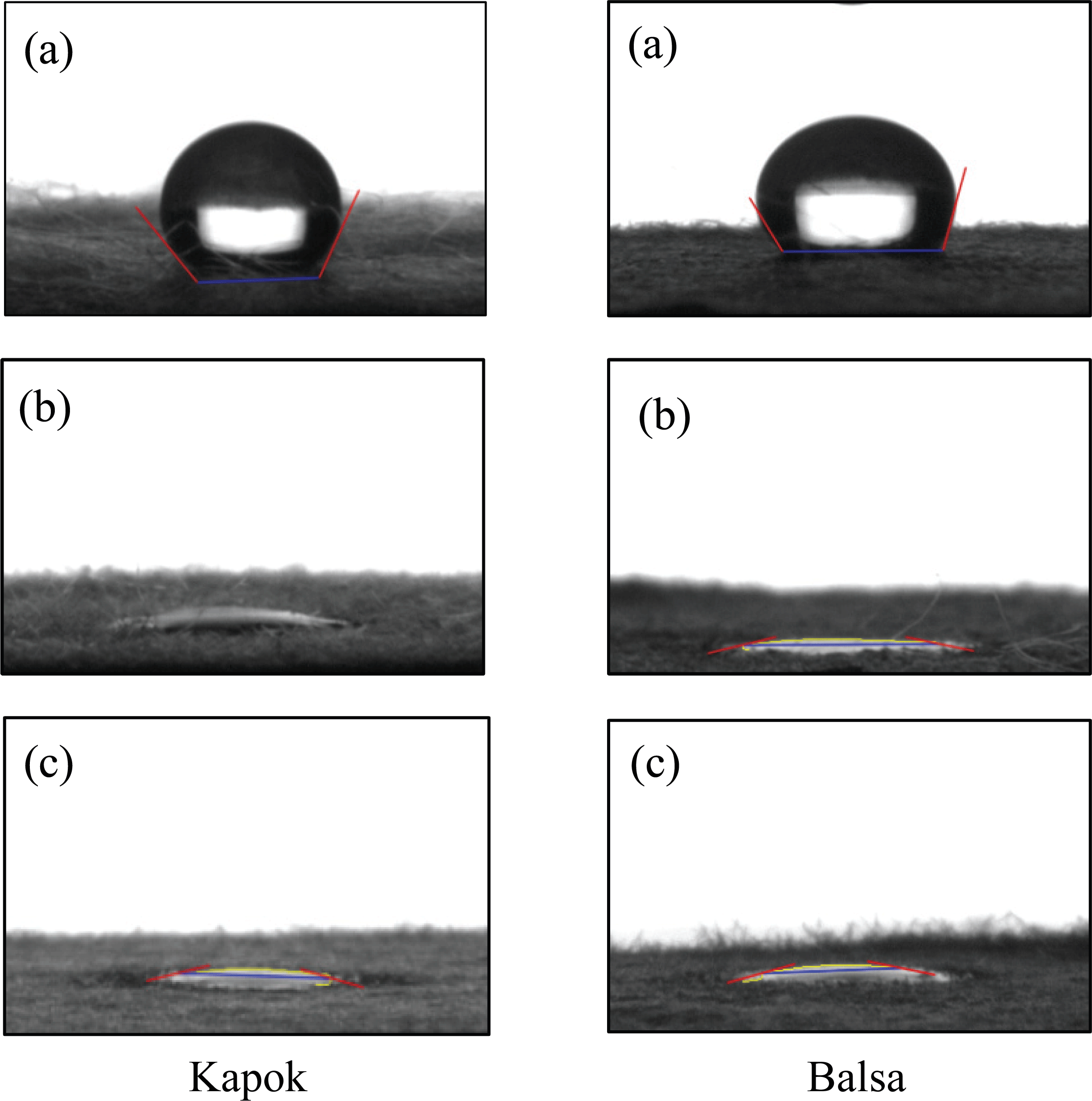
Contact angle is the angle between the fiber surface and the tangent to the drop profile at the drop edge (Njobuenwu et al., 2007). A large contact angle with water illustrates a hydrophobic and non-polar fiber surface. Hydrophobic properties are associated with the wax content of the fiber surface. Schellbach et al. (2015) stated that the wetting characterization of natural fibers through contact angle measurement aims to predict the compatibility and interaction between fiber and polymers that have various surface energies.
The DSC technique can be used to determine a drop in crystallinity and decomposition of plant fiber cellulose (Mwaikambo and Ansell 2002). There are three types of weight/mass loss during thermal degradation: water removal (drying), organic matter release (devolatilization), and bonded-carbon oxidation (slow combustion). From the DSC results, kapok and balsa fibers were shown to follow a similar fiber degradation process (Fig. 5).
The first peak is endothermic, and it indicated water desorption, as seen in the temperature range of 29.9 °C ‒ 65.1 °C for kapok fiber and 29.9 °C ‒ 57.0 °C for balsa fiber. The second and third peaks are exothermic, and they occurred at 322.8 °C and 444.1 °C for kapok fiber and at 333.2 °C and 434.7 °C for balsa fiber. The second peak was expected to represent the degradation of the hemicellulose, as well as the amorphous part of cellulose. According to Jin et al. (2010), hemicellulosic depolymerization might occur at a temperature of 180 °C ‒ 340 °C, and breakage of the cellulosic glycosidic bond might occur at 275 °C ‒ 350 °C (Poletto et al., 2012).
The third peak expressed the final decomposition of cellulose, as well as lignin degradation. Gaan et al. (2009) identified three stages of cellulose thermal decomposition. The first stage occurred at a temperature of 100 °C and represented the release of water. The second stage, at a temperature of 360 °C, was a rapid dehydration and decarboxylation reaction that produced combustible gases such as aldehydes, ketones, and ethers. The third stage, at 400 °C, was classified as the second stage of decomposition and charcoal formation. Lignin degradation occurred at a temperature of 250 °C ‒ 500 °C because of its high stability, which made it difficult to decompose (Poletto et al., 2012).
The solubility of balsa fiber in hot and cold water was higher than that of kapok fiber, and its content of α-cellulose, lignin, and silica was also higher than that of kapok fiber (Table 4). In contrast, the solubility in 1% NaOH and the content of ash and wax were higher for balsa than for kapok. Compared with cotton fiber, kapok fiber had a lower cellulose content and a higher lignin content (Mani et al., 2012). Cotton contained a significant amount of cellulose, ranging from 82% to 96%, with a lignin content of 0% ‒ 5% (Mwaikambo, 2006).
Previous studies on the chemical components of kapok stated that its fiber contained a large amount of organic lignin at 15% ‒ 22%, 35% ‒ 50% of cellulose, 22% ‒ 45% of hemicellulose, and 2% ‒ 3% of wax. It also contained small amounts of starch, approximately 2.1% of protein, and some inorganic substances, notably iron content of 1.3% ‒ 2.5% (Smole et al., 2013). Considering the content of α-cellulose, kapok was more similar to wood than flax and other plant fibers (Fengel, 1986).
The FTIR spectra of kapok and balsa fibers are shown in Fig. 6. There were similar absorption bands for both fibers. An -OH functional group appeared at a wavenumber of 3356 cm-1 for kapok fiber and at 3425 cm-1 for balsa fiber, and C-H stretching was found at a wavenumber of 2916 cm-1 for kapok fiber and at 2908 cm-1 for balsa fiber. Both functional groups of -OH and C-H at these wavenumbers indicated the presence of cellulose, hemicellulose, and lignin (Moran et al. 2008). Meanwhile, the carbonyl group (C=O) found at 1736 cm-1 indicated the presence of hemicellulose (Chandrabakty, 2014).
The absorption peak at 1250 cm-1 for both fibers was associated with stretching of the aryl-alkyl ether group in lignin (Nazir et al., 2013). Meanwhile, the characteristic band located at 1034 cm-1 for balsa fiber and 1049 cm-1 for kapok fiber indicated the vibration of C-O-C or C-O in cellulose (Solikhin et al., 2016).
4. CONCLUSION
Kapok and balsa fibers had hollow structures with thin fiber walls and large lumen; therefore, they could potentially be developed as absorbent and insulating materials. There were similarities in terms of structure and properties between kapok and balsa fibers derived from seedpods. Kapok and balsa fibers were significantly hydrophobic because of the wax content found on the surfaces of both fibers. The chemical compositions of natural fibers, represented by the percentage of cellulose, hemicellulose, lignin, and wax, also contributed largely to the characteristics of the products. The main chemical components of kapok and balsa were cellulose, hemicellulose, and lignin as supported by FTIR, XRD, and DSC analyses.









